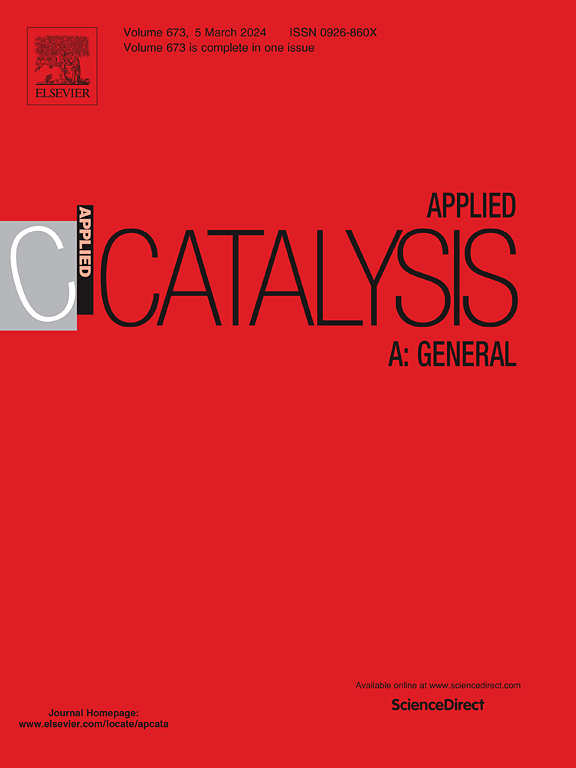生物燃料催化加氢脱氧研究进展:催化剂、机理和工艺
IF 4.7
2区 化学
Q2 CHEMISTRY, PHYSICAL
引用次数: 0
摘要
随着环境问题和能源危机的影响日益明显,零碳路线对于实现燃料的大规模生产至关重要,例如有效利用生物质生产生物燃料。本文从金属催化剂和反应机理两方面对废生物脂和木质纤维素加氢转化为生物燃料的研究进展进行了系统总结和指导。首先,综述了五种典型的金属催化剂,包括可还原金属氧化物、金属硫化物、金属磷化物、金属碳化物和金属氮化物。其中,可还原金属氧化物和金属硫化物因其高效的氢脱氧(HDO)活性而被广泛报道。探讨了贵金属和非贵金属催化剂的设计和制备,特别是催化剂活性位点的合理设计。对于金属硫化物,综述了新的原位合成方法,特别是在使用油溶性前体的HDO反应中,例如具有高度可设计基团的离子液体。然后讨论了支撑的重要性,特别是形态、协同金属-支撑相互作用和表面酸度对HDO性能的积极影响。随后,以棕榈酸甲酯为生物脂模型化合物,纤维素二糖为纤维素和半纤维素模型化合物,详细探讨了生物质加氢处理生产生物燃料的反应机理。我们还介绍了生物质氢转化为生物燃料的两个典型过程,涉及三个一般单元:预处理单元、HDO单元和分离单元。最后,本文对催化剂设计、一锅异构化、operando表征和反应工艺发展等方面的研究进展进行了总结和展望。本文章由计算机程序翻译,如有差异,请以英文原文为准。
A mini review on catalytic hydrodeoxygenation for biofuels production: catalyst, mechanism and process
As the effects of environmental problems and energy crises become apparent, zero carbon routes are vital to achieve large-scale production of fuels, such as efficient utilization of biomass to produce biofuels. This critical review provides a systematic summary and guidance on the catalytic conversion of waste biolipids and lignocellulose into biofuels via hydro-conversion in respect of metal catalysts and reaction mechanisms. First, five typical metal catalysts are reviewed, including reducible metal oxides, metal sulfides, metal phosphides, metal carbides, and metal nitrides. Among them, reducible metal oxides and metal sulfides are widely reported due to their efficient hydrodeoxygenation (HDO) activity. The design and preparation of catalysts from noble and non-noble metals, especially the rational design of catalyst active sites, are explored. For metal sulfides, novel in situ synthesis methods are summarized, especially in HDO reactions using oil-soluble precursors, such as ionic liquids with highly designable moieties. The importance of support is then discussed, particularly the positive effects of morphology, synergistic metal-support interactions, and surface acidity on HDO performance. Subsequently, the reaction mechanism of biomass hydrogenation treatment to produce biofuels was explored in detail using methyl palmitate as a biolipid model compound and cellobiose as cellulose and hemicellulose model compound. We also introduce two typical processes for hydro-conversion of biomass to biofuels involving three general units: pre-treatment unit, HDO unit, and separation unit. Finally, this review provides a summary and insights into catalyst design, one-pot isomerization, operando characterization, and reaction process development.
求助全文
通过发布文献求助,成功后即可免费获取论文全文。
去求助
来源期刊

Applied Catalysis A: General
化学-环境科学
CiteScore
9.00
自引率
5.50%
发文量
415
审稿时长
24 days
期刊介绍:
Applied Catalysis A: General publishes original papers on all aspects of catalysis of basic and practical interest to chemical scientists in both industrial and academic fields, with an emphasis onnew understanding of catalysts and catalytic reactions, new catalytic materials, new techniques, and new processes, especially those that have potential practical implications.
Papers that report results of a thorough study or optimization of systems or processes that are well understood, widely studied, or minor variations of known ones are discouraged. Authors should include statements in a separate section "Justification for Publication" of how the manuscript fits the scope of the journal in the cover letter to the editors. Submissions without such justification will be rejected without review.
 求助内容:
求助内容: 应助结果提醒方式:
应助结果提醒方式:


